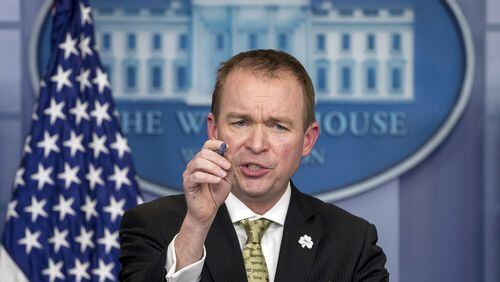Last week PolitiFact checked out three statements ranging from mostly false to mostly true: a White House official’s assertion that three prominent Democrats voted for a border wall in 2006; an online claim that more police were killed during the war on drugs compared with the Prohibition era; and Georgia 6th District congressional candidate Jon Ossoff’s claim of $16 billion worth of duplicate federal programs that could be cut.
Abbreviated versions of our fact checks are below. Full versions can be found at www.politifact.com.
“They voted for (a border wall) in 2006. Then-Senator Obama voted for it. Sen. Schumer voted for it. Sen. Clinton voted for it.”
— Mick Mulvaney on Sunday, April 23rd, 2017 in a segment on “Fox News Sunday”
White House budget director Mick Mulvaney said top Democrats voted for a border wall just over 10 years ago as he scolded Democrats for obstructing action on Trump’s proposed wall. He was referring to their votes on the Secure Fence Act of 2006, which authorized about 700 miles of fencing along the border, more vehicle barriers, checkpoints and lighting to curb illegal immigration, and the use of advanced technology such as satellites and unmanned aerial vehicles.
Senators Barack Obama, Hillary Clinton and Chuck Schumer and 23 other Democratic senators voted in favor of the act when it passed in the Senate 80-19. But there are differences between the fence and Trump’s wall proposal. Trump criticized the 2006 fence during the 2016 campaign, saying, “it was such a little wall, it was such a nothing wall.”
Our ruling
Obama, Schumer and Clinton did vote for the Secure Fence Act of 2006, which authorized building a fence along about 700 miles of the border. The fence they voted for is not as substantial as the wall Trump is proposing. Trump called the 2006 fence a "nothing wall." Mulvaney's statement is partially accurate, but ignores important context. We rate it Half True.
“After prohibition ended, police deaths didn’t reach 200 a year again until the year Nixon declared war on drugs.”
— Viral image on Thursday, April 20th, 2017 in posts on social media
On April 20, the unofficial stoner holiday 4/20, supporters of legal marijuana and opponents of the U.S. “war on drugs” took to the internet. The words accompanying one widely shared image say in part: “More American police officers died during prohibition of alcohol than any other time in history. 300 died in 1930 alone. After prohibition ended, police deaths didn’t reach 200 a year again until the year Nixon declared war on drugs.”
Comparing Prohibition with the drug war is common in American culture. But is it also fair to compare police deaths during the two periods? That’s a little iffy.
The numbers behind the claim that “police deaths didn’t reach 200 a year again until the year Nixon declared war on drugs” are a bit off. Nixon began the war on drugs in 1971, but police deaths actually topped 200 the year before that, in 1970. And that wasn’t any sort of a spike. The number of deaths had been just below 200 all throughout the late 1960s. As for the number of officers who die each year during the war on drugs, in reality that’s only happened 12 times, and only twice since 1981. In fact, during most years from the 1990s until today, the number of officer deaths has been roughly the same as 100 years ago, when there were far fewer officers.
Our ruling
Police deaths have largely been on the decline for decades even as the drug war continues, and the number of officers has grown significantly. Since the image uses a semi-accurate statistic to make a misleading comparison, we rate this claim Mostly False.
In the federal government, “there’s $16 billion in duplicate programs. That can be cut.”
— Jon Ossoff on March 30 in a campaign ad
We wondered where that $16 billion figure came from. The Ossoff campaign sent us to a report published every year since 2011 by the Government Accountability Office, the respected, nonpartisan, investigative arm of Congress. The report is designed to point out programs, offices and practices that duplicate other government functions or fail to provide value for the taxpayer.
Ossoff’s campaign said the $16 billion figure came from several line items in the GAO report that he has reviewed and believes can be eliminated in short order without significant harm. The report includes a wide range of additional recommendations Ossoff has not explicitly said he supports, which it says could produce at least $13 billion in additional specified savings.
Our ruling
Ossoff 's statement is accurate but needs clarification, so we rate it Mostly True.






